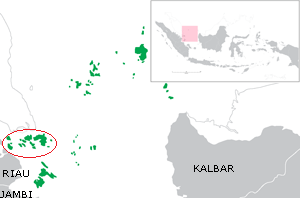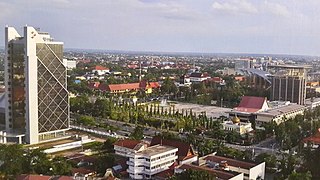Related Research Articles

The economy of Indonesia is a mixed economy with dirigiste characteristics, and it is one of the emerging market economies in the world and the largest in Southeast Asia. As an upper-middle income country and member of the G20, Indonesia is classified as a newly industrialized country. Estimated at over 21 quadrillion rupiah in 2023, it is the 16th largest economy in the world by nominal GDP and the 7th largest in terms of GDP (PPP). Indonesia's internet economy reached US$77 billion in 2022, and is expected to cross the US$130 billion mark by 2025. Indonesia depends on the domestic market and government budget spending and its ownership of state-owned enterprises. The administration of prices of a range of basic goods also plays a significant role in Indonesia's market economy. However, since the 1990s, the majority of the economy has been controlled by individual Indonesians and foreign companies.

Riau is a province of Indonesia. It is located on the central eastern coast of Sumatra along the Strait of Malacca. The province shares land borders with North Sumatra to the northwest, West Sumatra to the west, and Jambi to the south, and a maritime border with the Riau Islands and the country of Malaysia to the east. It is the second-largest province in the island of Sumatra after South Sumatra, and is slightly larger than Jordan. According to the 2020 census, Riau had a population of 6,394,087 across a land area of 89,935.90 km²; the official estimate of population as of mid-2022 was 6,614,384. The province comprises ten regencies and two cities, with Pekanbaru serving as the capital and largest city.

The Riau Islands is a province of Indonesia - not to be confused with neighbouring Riau Province from which the islands were separated in 2002. The capital of the province is Tanjung Pinang and the largest city is Batam. It shares a maritime border with Riau and Jambi to the east, Bangka Belitung Islands to the south, Singapore to the northeast, Malaysia and West Kalimantan to the west, and Vietnam and Cambodia to the north. It comprises a total of 1,796 islands scattered between Sumatra, Malay Peninsula, and Borneo including the Riau Archipelago. Situated on one of the world's busiest shipping lanes along the Malacca Strait and the Natuna Sea, the province shares water borders with neighboring countries such as Singapore, Malaysia, and Brunei. The Riau Islands also have relatively large potential mineral resources and energy, as well as marine resources.

The Riau Archipelago is a geographic term for the core group of islands within the Riau Islands Province in Indonesia, and located south of Singapore and east of Riau on Sumatra. Before the province of Riau Islands was formed, there was no ambiguity in term; however, in Indonesian language, both the archipelago and administrative province are referred to simply as "Kepulauan Riau". The province may have the word "Provinsi" preceding it for clarity. Additionally, the term BBK for Batam Bintan Karimun may refer to the archipelago.

Batam is the largest city in the province of Riau Islands, Indonesia. The city administrative area covers three main islands of Batam, Rempang, and Galang, as well as Bulang to the west and several small islands. Batam Island is the core urban and industrial zone, while both Rempang Island and Galang Island maintain their rural character and low-density population; they are connected to Batam Island by short bridges. Bulang Island and the islands to its north forming Belakang Padang District lie to the west of Batam Island but are also administratively within the city. Batam is an industrial boomtown, an emerging transport hub, and part of a free trade zone in the Indonesia–Malaysia–Singapore Growth Triangle, located 20 km (12 mi) off Singapore's south coast.

Pekanbaru is the capital city of the Indonesian province of Riau, and a major economic centre on the eastern side of Sumatra Island with its name derived from the Malay words for 'new market' . It has an area of 632.26 km2 (244.12 sq mi), with a population of 897,767 at the 2010 Census, and 983,356 at the 2020 Census; the official estimate as at mid 2022 was 1,007,540. It is located on the banks of the Siak River, which flows into the Strait of Malacca, Pekanbaru has direct access to the busy strait and has long been known as a trading port.

Bintan Island or Negeri Segantang Lada is an island in the Riau archipelago of Indonesia. It is part of the Riau Islands province, the capital of which, Tanjung Pinang, lies in the island's south and is the island's main community.

Great Karimun, also known as Mawas Island, is one of the islands in the Riau Islands province of Indonesia, administratively part of Karimun Regency. It lies about 37 km southwest of Singapore, 54 km west of Batam, 24 km northeast of Rangsang Island and 32 km north of Kundur Island.

The Lingga Regency is a group of islands in Indonesia, located south of Singapore, along both sides of the equator, off the eastern coast of Riau Province on Sumatra island. They are south of the populated Riau Archipelago, known for the industrial island of Batam and the tourist-frequented island of Bintan, although the Lingga Islands themselves are rarely visited due to the infrequent local transportation. The equator goes through the northern tip of Lingga Island, the main island in the archipelago.

Tanjungpinang, also colloquially written as Tanjung Pinang, is the capital city of the Indonesian province of Riau Islands. It covers a land area of 144.56 km2, mainly on the southern Bintan Island, as well as other smaller islands such as Dompak Island and Penyengat Island. With a population of 227,663 at the 2020 Census, it is the second largest city of the province, after Batam; the official estimate as at mid 2022 was 239,854. Tanjungpinang is a historic city of the Malay culture, having served as the capital of both Johor Sultanate and Riau-Lingga Sultanate.
Bulan Island or Pulau Bulang is an island located 2.5 km south-west of Batam Island, with a land area of 100 km2. It is located in the Sijori Growth Triangle, Riau Islands Province, Indonesia. It is the largest island adjacent to Batam on its western side and is administratively part of Batam city. The strait between them is shallow and land reclamation and island amalgamation is feasible.
The Indonesia–Malaysia–Thailand Growth Triangle (IMT-GT) started as an early attempt at economic liberalisation & integration in ASEAN. It was formally endorsed by Indonesia’s President Suharto, Malaysia’s Prime Minister Tun Dr. Mahathir Mohammad and Thailand’s Prime Minister Chuan Leekpai in 1993.

Johor, is a state of Malaysia in the south of the Malay Peninsula. It shares borders with Pahang, Malacca and Negeri Sembilan to the north. Johor shares maritime borders with Singapore to the south and Indonesia to both the west and east. As of 2023, the state's population is 4.19 million, making it the second most populous state in Malaysia, after Selangor. Johor Bahru is the capital city and the economic centre of the state, Kota Iskandar is the state administrative centre and Muar serves as the royal capital.

Indonesia and Malaysia established diplomatic relations in 1957. It is one of the most important bilateral relationships in Southeast Asia.

The Singapore Strait crossing is a proposed tunnel, bridge or combination of the two spanning the Singapore Strait and linking Singapore with the Riau archipelago of Indonesia, most likely with the island of Batam. In the early 1990s the Riau Islands experienced a major economic boom in response to the development of an industrial estate on Batam, located 15 km (9 mi) southeast of Singapore. Singapore and Batam currently are connected only by ferry service.

Indonesia and Singapore established diplomatic relations on 7 September 1967, a month after the formation of the Association of Southeast Asian Nations (ASEAN) on 8 August 1967. Indonesia and Singapore are two of the five founding members of ASEAN. Both nations are also members of the Non-Aligned Movement and APEC.
The Timor-Leste–Indonesia–Australia Growth Triangle (TIA-GT) is a combined initiative of the regions of Eastern Indonesia, Northern Australia, and the Democratic Republic of Timor-Leste. This initiative aims to promote and foster economic growth through integrated economic development in the region that these nations reside in. The growth triangle was created in 2012, after a meeting was held by Indonesian president Susilo Bambang Yudhoyono with Prime Minister of Australia Julia Gillard and Timor-Leste Prime Minister Xanana Gusmao. The initiative aims to support economic, social, and cultural development primarily by attracting investment, developing manufacturing industries, enhancing human capital, and overall building a stronger cooperative relationship between the three countries involved. The initiative also aimed to accelerate the accession of Timor-Leste into the Association of Southeast Asian Nations (ASEAN) and to fulfill goals set by Timor-Leste's Strategic Development Plan, such as increasing the nation's economic prosperity and stability. The growth triangle is often misinterpreted as a free-trade zone; however, while there are elements of free trade agreements between Indonesia and Australia specifically, the terms of the growth triangle initiative are not directly linked to these free trade agreements, and the goals of the growth triangle do not specifically encompass free trade between the three nations.
References
- ↑ "Growth triangle". National Library Board. Archived from the original on 9 September 2010. Retrieved 28 August 2010.
- ↑ Fadli (15 July 2014). "Increasing wages driving investors out of Batam Island". The Jakarta Post . Archived from the original on 22 May 2021.
- ↑ Gabriel, Anita (30 March 2012). "Indonesia's Batam Losing Its Economic Luster". The Jakarta Post . Archived from the original on 16 November 2012. Retrieved 17 December 2012.
- ↑ "Latest Data". Statistics Singapore . Archived from the original on 5 November 2014. Retrieved 5 January 2014.
- ↑ "PDRB Kepri Triwulan I Tahun 2014 Tumbuh 5,21 Persen" [Riau Islands GDRP Quarter I Year 2014 Grows By 5.21 Percents]. Badan Pusat Statistik Provinsi Kepulauan Riau (in Indonesian). 5 May 2014. Archived from the original on 21 May 2014. Retrieved 21 May 2014.
- ↑ "Latest Data". Statistics Singapore . Archived from the original on 5 November 2014. Retrieved 5 January 2014.
- ↑ "Johor @ a Glance". Archived from the original on 21 May 2014. Retrieved 21 May 2014.